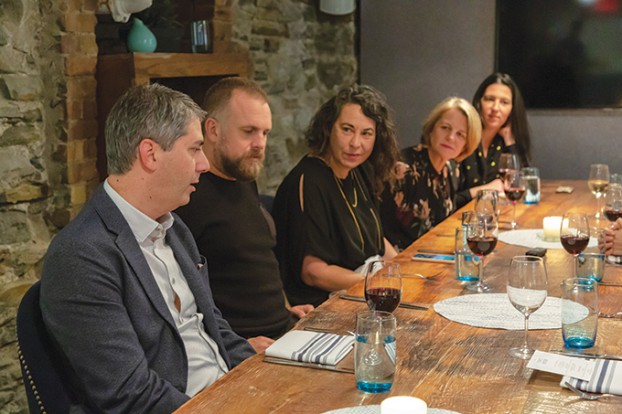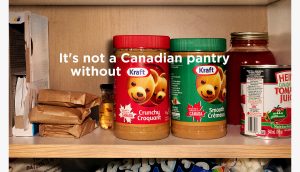Pictured above: Boston Pizza’s Koho’s Jason Chaney, Agents of Necessity’s Sarah Ivey, The Globe and Mail’s Tracy Day, strategy’s Lisa Faktor.
This story originally appeared in the January/February 2019 issue of Strategy.
With budgets in flux and brand priorities ever-changing, Strategy met with industry experts to figure how to create sustainable business models for brands, agencies and media companies. For all three to succeed, each needs to be healthy and profitable. So, in the first of four roundtables in this year’s series, we look at the issues through a brand lens. How can partners evolve to enable marketers to create better (affordable) programs in a mediascape with dwindling resources? Read on to learn what they believe is working, what’s not, and where to go next.
In attendance were Emma Eriksson, VP of marketing at General Mills Canada, Adrian Fuoco, senior director of marketing for Boston Pizza, Jason Chaney, chief creative officer for Koho, Sarah Ivey, CEO and founder of Agents of Necessity, Alex Panousis, president of Havas Media and Sarah Thompson, chief strategy officer at Mindshare.
Moderating the discussion were strategy publisher Mary Maddever and Media in Canada editor Bree Rody-Mantha.
How, and where, can agencies and clients collaborate more efficiently and effectively?
 General Mills’ Emma Eriksson: Well, there are lots more targeting opportunities, but you need content, right? I need [agency partners] who understand my target and I need to create a lot of content. That’s where I’ve felt there have been great opportunities.
General Mills’ Emma Eriksson: Well, there are lots more targeting opportunities, but you need content, right? I need [agency partners] who understand my target and I need to create a lot of content. That’s where I’ve felt there have been great opportunities.
Boston Pizza’s Adrian Fuoco: We have a content challenge as well. Within a campaign window, I’ve got to think about making one great TV ad and 15 other assets, and I have to spread the budget across all of them. So now everything is getting a bit watered down and maybe not of the same level of quality. Of course, nobody wants that.
The other challenge related to content is knowing if we’re actually producing the right content for the channel. When I go back to the 30-second ad unit from my training, I basically know how this thing should come together for it to work. But then when I’m buying ads on social, I’m not really sure what the right content is for each of the 20 products on Facebook, and I’m not always sure our media partners know either. That’s because it’s changing so rapidly. And so there are these other discussions between the client and the partner happening directly, and the agency may not be a part of that, and that’s also complicating things.
Agents of Necessity’s Sarah Ivey: Do you think we’re just trying to check boxes? I think about the Nike campaign with Colin Kaepernick this year. In some ways it was so simple, and in so many ways it was complicated. But it took advantage of political discourse and it just tapped into culture in such an interesting way. But I look at that and I think, ‘That was advertising. Wow.’ They ran it, got PR and my 80-something-year-old mother knows about it.
 Mindshare’s Sarah Thompson: Media agencies, especially my team, are pushing to create better things with our media partners. The challenge is that now I’m pushing my media partners. I want something more robust. I don’t want your rate card with a simple, cookie-cutter answer to my brief. I want us to have a conversation of, ‘I think there’s something to this topic, and I think this brand has the personality to bring it to light,’ and have a discussion and a dialogue very similar to Nike. It’s not a, ‘I just need five articles and two videos and an influencer.’ It has to be more complicated and we can’t rush to get to a great result. Nike has permission. I want more brands to figure out how they can get permission.
Mindshare’s Sarah Thompson: Media agencies, especially my team, are pushing to create better things with our media partners. The challenge is that now I’m pushing my media partners. I want something more robust. I don’t want your rate card with a simple, cookie-cutter answer to my brief. I want us to have a conversation of, ‘I think there’s something to this topic, and I think this brand has the personality to bring it to light,’ and have a discussion and a dialogue very similar to Nike. It’s not a, ‘I just need five articles and two videos and an influencer.’ It has to be more complicated and we can’t rush to get to a great result. Nike has permission. I want more brands to figure out how they can get permission.
Eriksson: I feel like, as a brand, you’ve got to aim for something remarkable, you’ve got to take risks, you’ve got to stand for something. I think that talking [with your partners] directly and finding the right fit prevents things from getting lost in translation, or in this bureaucracy of things.
Havas’ Alex Panousis: So what are the companies like Procter and Unilever doing? Well, they’re creating their own agencies. It’s as if they think that they’re going to do a better job. Part of our business is to commoditize, so frankly anyone can do it. But what we really need is strategy, ideas, connection.
Koho’s Jason Chaney: The folly of the industry is partly procurement and marketers who think they’re going to get more value by pressing on the cost of an agency, and also partly the agency who has acquiescently said, ‘You’re right, we have no value and to compensate for that we’re going to hire a bunch of junior people so we can keep our margins going and I can fool you into thinking we’re creating value,’ when you’re not creating value. A lot of agencies are going to have atrophy. The opportunity is to hire more senior, capable people and stop making incredibly talented creative and media people administrators. Then make them do their work and charge for it.
 Panousis: I look back and I do think we’ve done a lot of that, for sure, but I also think we’ve been self-indulgent. We’ve taken things for granted, and at a time when we should have been doubling down. And this is the problem we’re trying to solve. Instead of taking clients to Cannes, we now go to anthropological talks that look at how to solve problems through heavy research, or a systematic way of uncovering the real problem.
Panousis: I look back and I do think we’ve done a lot of that, for sure, but I also think we’ve been self-indulgent. We’ve taken things for granted, and at a time when we should have been doubling down. And this is the problem we’re trying to solve. Instead of taking clients to Cannes, we now go to anthropological talks that look at how to solve problems through heavy research, or a systematic way of uncovering the real problem.
Thompson: I think to Jay’s point, there’s not a day that goes by when they don’t ask, ‘What’s your FTE?’ and then you take a staffing chart and say, ‘You get 5% of this person.’ What is possible with 5% of a person? On my own team, I have really smart, talented marketing science people and comms planners, so I don’t care about the billable hour because we create value for our clients and that is sufficient. The money will get made somehow, somewhere, and you need to have the faith that it will follow.
Panousis: I disagree. I think that’s part of the problem, because we didn’t understand how to make money and how to charge. You don’t go to a universally renowned architect and go, ‘$750? Let’s go $700. $650. Can you do it for $50?’ And then we say, ‘Here’s what we can do for $50.’ That’s when we’ve hit rock bottom. We dug this hole and now it’s hard to get out of it. Those that get out of it are going to be the ones that take what Wealthsimple did, which is turning the model on the head.
 Ivey: I actually think the whole trend in more project-based stuff is a Godsend for agencies, because you have a clear delivery model and then you staff for it. You’re selling a product. And how do you style yourself like a product?
Ivey: I actually think the whole trend in more project-based stuff is a Godsend for agencies, because you have a clear delivery model and then you staff for it. You’re selling a product. And how do you style yourself like a product?
Thompson: There’s a lot of that value-based pricing conversation on the agency side.
Chaney: I think there’s a general insecurity about the actual ability to deliver. And I don’t think a lot of people who know what they’re doing are selling the fact that they know what they’re doing.
When it comes to content, are we trying to do too much with too little dollars and is nobody pushing back?
Thompson: It’s exactly what Jay’s talking about. At the end of the day, we do a pitch with our clients where they get to see the brightest minds at the agency and then they never see them again. And then you’ve got the junior talent who don’t challenge the brief. They look at it and think, ‘I don’t know how to challenge this because I’ve never even been taught to have the soft skills to challenge the thinking on this.’ We end up in this perpetual cycle where it’s not big things, it’s a lot of little things. We’re creating this overwhelming amount of stuff that nobody even has the time to digest. That part of it is what needs to stop. You don’t need to fill up every channel with every single piece of content.
I’m a big proponent of ‘great creativity needs a great canvas.’ But as much as we have all of the data and the insights and the information to be able to provide a great canvas, if you’ve never seen how people shop your client’s brand in a store, how do you know anything that you’re doing is working? Get out of your agency and see what the world is actually like.



















